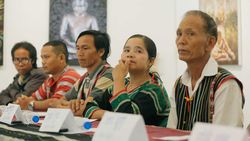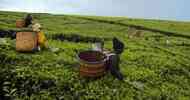Courting justice: when legal challenges to corporate land grabs go wrong
Contributed by: Sango Mahanty, Jean-Christophe Diepart and Sarou Long
In July 2021, a French court ruled against a group of Indigenous Bunong farmers from Mondulkiri in Northeastern Cambodia. Represented by French Laywer Fiodor Rilov, and with civil society support, the group accused the French Bolloré Group and their subsidiary company, Compagnie du Cambodge (controlled by Socfinasia) of illegal land seizures and the wanton destruction of Bunong sacred forests and their way of life. The disputed land consists of agricultural concessions granted by the Royal Government of Cambodia in 2008 and 2010 to Socfin-KCD (a joint venture of Cambodian company Khao Chuly Development and Socfinasia). Court cases of this kind are familiar to Socfin, who has faced similar complaints in Africa.
The outcome was striking not only for the ease with which the court dismissed the case, but also for the unprecedented requirement that the Bunong plaintiffs pay Euro 20,000 in reparations to Bolloré and its Cambodian subsidiary. In light of recent discussions on the potential and constraints of legal activism, we aim here to highlight entrenched structural factors that can hinder communities in legal challenges to corporate land grabs.
The political and economic power of corporate actors like Bolloré and Socfin run deep. Established in the early 1900s, Socfin (Société Financière des Caoutchoucs) played a key role in mobilising European capital to French Indochinese frontiers to develop rubber plantations. As a holding company, Socfin then designated these lands to various subsidiaries for development – a pattern that served to complicate regulation of these corporate actors and their landholdings even in colonial times. The Compagnie du Cambodge cited in this court case was one such subsidiary and shares Socfin’s colonial origins. The high-level connections of companies like Socfin were central to their economic success. In one example cited by French economist Charles Robequain (1944), when Socfin’s Adrien Hallet arrived in French Indochina 1910 he quickly gained agreement from the Colonial administration to mark off ten square kilometres of forest on the Cochinchina-Cambodia border for future development into rubber. In a mark of Hallet’s influence, “the border was pushed back a little” to accommodate this land grant.
Socfin-KCD’s lease of the three Mondulkiri concessions at the heart of the current legal case similarly gained easy government approvals, given KCD’s connections with Cambodian political leaders. These include the concessions known as Varanasi (2,705 ha, granted in 2008), Sethikula (4,273 ha, granted in 2010) and Covyphama (5,345 ha, granted in 2008). In Cambodia, government approvals for plantation investments by domestic companies routinely avoid the consultation, environmental and social assessment requirements of the Sub-Decree on Economic Land Concessions, as well as the national environmental impact assessment guidelines. The involvement of European finance might have invoked international safeguards if investors had sourced funds from the IFC or from banks that subscribe to the Equator Principles, but Socfin’s annual reports suggest that it used other sources of finance for this purpose.
With Cambodian due-diligence procedures by-passed and in the absence of formal international safeguards, Socfin’s operations were only subject to ‘soft laws’ such as the OECD’s Guidelines for Multinational Enterprises, and to the company’s own voluntary corporate social responsibility principles. Socfin explains on its website that the company voluntarily follows a range of international performance standards (World Bank, RSPO Principles, and the Sustainable Natural Rubber Initiative) and also “adheres scrupulously” to national land ownership and environmental legislation. Yet many countries where the company invests, Cambodia included, are settings where land rights, environmental laws and human rights are routinely flouted.
Socfin has become a visible target for community anger, but there are complex financial relationships between companies at play in this case, echoing the opaque colonial financial networks mentioned earlier. Socfinasia is the key company in the Socfin-KCD joint venture. Registered on the Luxembourg Stock Exchange, Socfinasia is a subsidiary company owned by Socfin (58%) and the Bolloré Group (22%). The Bollore group also owns the Compagnie du Cambodge mentioned in this case, and 39% of the share in Socfin. These intricate corporate relationships can serve to muddy the lines of accountability.
The French legal case addresses this corporate accountability issue. Rilov observed that the Bunong case would be the first in France against a parent company for actions overseas by a subsidiary, although such cases had been heard in the US and the UK. In reflecting on the challenges of mounting such a cross-jurisdictional legal case, he noted the important facilitating role of international and Cambodian actors such as Global Witness, British legal firm Leigh Day, the Cambodian Indigenous Youth Association (CIYA) and Cambodian lawyer Sek Sophorn. It was through these connections and relationships that Rilov ultimately developed the case with a group of 80 Bunong farmers against Socfin-KCD and the Bolloré Group for their loss of vital income and sacred forests.
The court ruled the Bunong case inadmissible on the grounds that none of the plaintiffs held title documents to prove their personal right to use the land, and for their alleged delays in submitting documentation. This emphasis on individual land titles is at odds with the customary and collective land tenure system that governs land access in Bunong communities. Yet, the Cambodian legal framework does recognise Indigenous Peoples’ rights to possess land and to use forest products (Civil Code; the 2001 Land Law and the 2002 Forestry Law). In particular, the 2009 sub-decree #83 under Cambodia’s Land Law enables formal recognition of lands where Indigenous people have cultural ties and that they have traditionally used for forest products and shifting cultivation.
The court might have been satisfied if the Bunong plaintiffs held a communal land title (CLT) for the contested areas under the 2009 sub-decree mentioned above. However, the process of formalising CLT is known to be complex, costly and time-consuming, with only 33 titles registered so far around the country. Furthermore, the 2009 sub-decree came after the ELCs had already been allocated to Socfin-KCD and clearance work commenced. Although the Cambodian Ministry of Interior has recognised Indigenous community bodies, meeting the second step in the land registration process, titling has been complicated by the existing land allocations. A community leader explained in 2016 that many of the areas they could potentially claim in a communal title application were already occupied by Socfin. Thus, the Bunong community has been unable to secure Indigenous communal title.
The option of gaining private land titles has also bypassed many Bunong families around the Socfin-KCD concessions. The Cambodian government’s fast-tracked private land titling campaign in 2012-2013 aimed to address land conflicts between economic land concessions and smallholder farmers across the country. The focus on individual private titles rather than communal lands caused friction within Bunong communities, but some families were keen to gain land security on these terms. Gaps and inequities in implementation are well documented with this intervention. Here too, a 2020 study found that some 26 percent of their studied land plots were titled during this process, of which around 71% went to Khmer migrants rather than Bunong people. A key constraint was that company did not permit the measurement and titling of land inside the concessions. The Bunong community thus lost out both on private titles and communal titling, further weakening their legal standing in the French case.
Importantly, none of the international protections for Indigenous peoples (e.g. the International Labour Organisation Convention on Indigenous and Tribal Peoples, Convention No. 169 of 1989; and the UN Declaration on the Rights of Indigenous Peoples, and the World Bank’s Environmental and Safety Standards No. 7) are predicated on formal evidence of land ownership. The French decision thus reflects a particularly narrow reading of the law where land rights are equated with formal titles.
Notably, other non-judicial processes have been mobilized by the company and non-state parties to compensate the villagers and address their grievances. The company has offered to address the conflicts through monetary compensation, land swaps for other locations or leasing of some concession lands as smallholder rubber plantations. The implementation of these options was problematic in many respeccts, however some community members accepted the small cash compensation (150-200 USD/ha) offered to them (Chan et al. 2020 and FIDH). In 2016, the company and three groups of villagers (not those involved in the trial) agreed to use an independent mediation process. The process is a locally contested, however, and concerns a limited section of the disputed land.
As far as the trial is concerned, the Bunong representatives and their French supporters are appealing the decision on the grounds of their ancestral ties to land. Yet, it is difficult to see how the case can progress through a system that is so heavily swayed towards politically and economically powerful actors, who can position themselves favourably within legal systems that disenfranchise Indigenous groups for their lack of formal property rights.
The case points to larger challenges for Indigenous communities in using judicial processes to counter corporate land grabs. Here, legal activism has forged important alliances and community action, but also exposes a highly unequal playing field both within Cambodia and Europe and the associated challenges in seeking land justice across jurisdictions.














